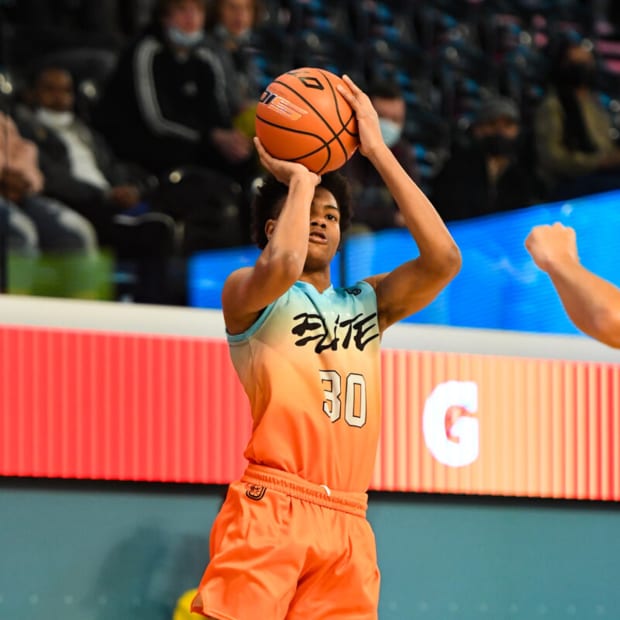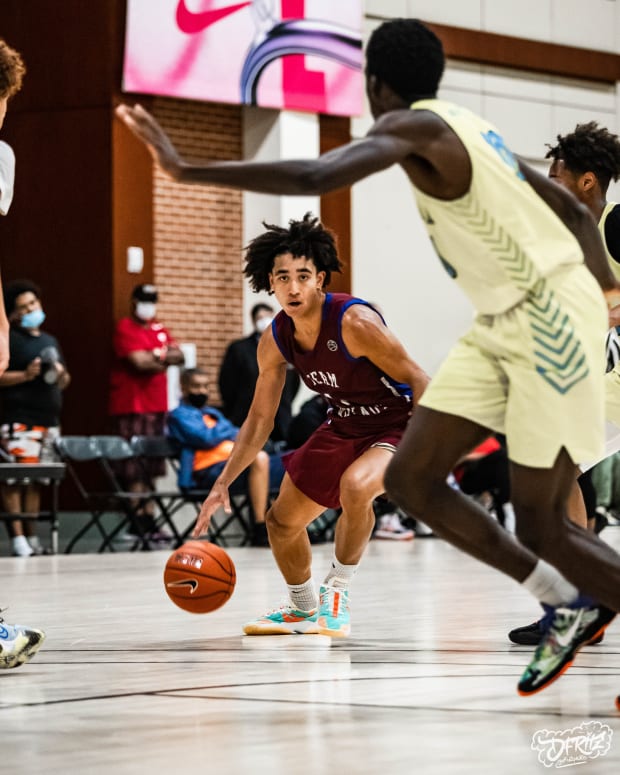Last May when Michael Foster told Sports Illustrated that he was bypassing college for the pros, opting to suit up for the G League Ignite instead, he referred to his move as “the golden path.”
“It’s the thing to do right now,” Foster said.
Two and a half months later on July 1, the NCAA shifted the landscape of college athletics by changing its policy to allow student-athletes to profit from their name, image and likeness (NIL).
“It’s a whole new world now,” says Centennial (Corona, Calif.) shooting guard Jared McCain, a Duke commit. “Everything is different. Everything.”
College coaches often refer to NIL as the ultimate equalizer from the perspective of players picking schools they might’ve otherwise overlooked due to a sweeter NIL deal, but perhaps the larger NIL win for colleges is its ability to potentially beat the pro enticement at its own financial game.
“I feel like it kinda killed the G League’s momentum, to be honest,” says Link Academy (Branson, Mich.) wing Omaha Biliew, a rising senior who is considering the G League, Kansas, Iowa State and Oregon. “Now players are getting even bigger paydays by going to college. Some of these deals are pretty crazy.”

Overtime Elite
In 2019, the G League offered contracts to a select group of high school stars worth $125,000. The following year, the NBA launched the Ignite team, swiping SI All-American Player of the Year Jalen Green and SI99 wing Jonathan Kuminga for a reported $500,000 apiece.
Not a bad payday by any stretch, but when you compare it to the report that a 2023 five-star football recruit signed a NIL deal with a school’s collective that could be worth more than $8 million by the end of his junior year of college, the half-million-dollar wow factor gets obliterated.
Ridge View (Columbia, S.C.) forward G.G. Jackson, arguably the top player in the 2023 class, already turned down the G League for North Carolina, while other top-tier rising seniors like Brewster Academy (Wolfeboro, N.H.) wing Matas Buzelis, Camden (N.J.) center Aaron Bradshaw and Duncanville (Texas) forward Ron Holland are still weighing college and pro options.
After Overtime Elite swiped talented twins Amen and Ausar Thompson, Bryson Warren, Jalen Lewis and Tyler Smith last year, there’s been a halt to the pro path in the 2023 class.
In April, Gill St. Bernard’s (Gladstone, N.J.) wing Nassir Cunningham, who is widely regarded as the top player in the 2024 class, committed to play for Overtime Elite but declined the six-figure salary—the minimum is $100,000—in order to maintain his NCAA eligibility.
“NIL has changed the game, that’s for sure,” Baylor associate head coach Alvin Brooks III says. “Branding is accepted as a part of the process now. We have a creative team that helps players with pictures and visuals for them to post so they can enhance their brands. I even remind them sometimes to post. If they don’t they’re doing themselves a disservice.”
Sure, players who take the pro route by way of the G League or Overtime Elite are free to pursue endorsement deals, but with minuscule marketability in a league that lacks eyeballs, players are facing an uphill battle selling themselves to companies.
College basketball is a marketing dream, stocked full of SportsCenter hits, primetime games and the golden goose that is the NCAA tournament and March Madness.
“I don’t know a player that doesn’t want to experience playing in the tournament,” McCain says. “It’s the biggest event in sports. We all dream of advancing every weekend in March and making those memories. Are you kidding?”

DFRITZ
Overtime Elite's director of scouting and recruiting Tim Fuller understands both perspectives. He served as an assistant and associate head coach at the Power 5 level for more than eight years and maintains that, financial incentives aside, the two paths remain in stark contrast.
"What we've been very cautious of and careful about is that you come to OTE to build pro habits and develop a pro skill set," Fuller says. "Overtime isn't for everybody, but the majority of homes that we sit in, the kids don't necessarily get into the NIL or pro money; it's more about who the coach is, where am I living, what am I eating and those are more the things that we address. I look at it like we're the premiere developmental opportunity for 19 and under here in the United States.
"Look at All-NBA first team: You’ve got Luka [Dončić], Giannis [Antetokounmpo] and [Nikola] Jokić, but what about our kids here domestically? Somebody has to start to give them the Luka package. If that doesn’t start to happen, we’re gonna see less and less of our kids dominating at the ultimate level. At OTE that's what we're doing.”
Word of God Christian Academy (Raleigh, N.C.) forward Brandon Gardner sees those benefits crystal clear as he mulls over an offer from Overtime Elite along with an impressive list of colleges that includes everyone from Kansas to St. John’s to Auburn.
To Fuller’s point, Gardner’s greatest deciding factor will be rooted in experience, not finances.
“For me, it’s about whether I want to go in and get the college experience or go where I can focus solely on basketball,” Gardner says. “With NIL, the money part is pretty even, depending on where you go, so I let that take care of itself. But you never know who you could meet in college, and you get the exposure of March and everything like that. As a pro, you’re training with other pros and you get to put everything into your craft. That’s big.”
Biliew echoed Gardner’s sentiments and said while NIL weakened the pro lure, the benefits of operating in an all-business setting can’t be understated.
The pro path should get even more shine later this month; between the G League and Overtime Elite there are currently seven players projected to be taken in this year's NBA Draft.
“I heard Kobe [Bryant] say one time that he never dreamed of being a college player, he only dreamed of being a pro,” Biliew says. “So I think about that, too. It’s like, what’s the ultimate goal here? Taking the pro route gives you a chance to be around pros all the time, soaking up the game, training like a pro and all of that. Even with NIL closing the money gap, that’s a part that the pro route will always have over college. It’s not an easy choice at all.”







